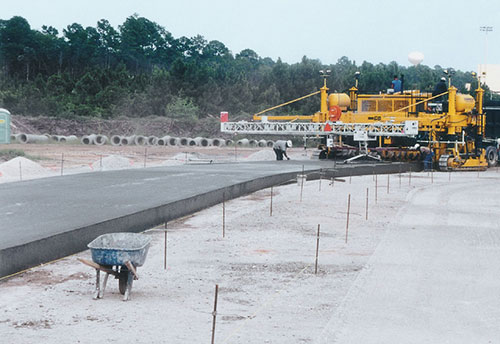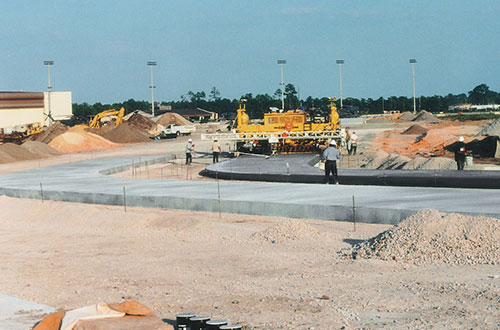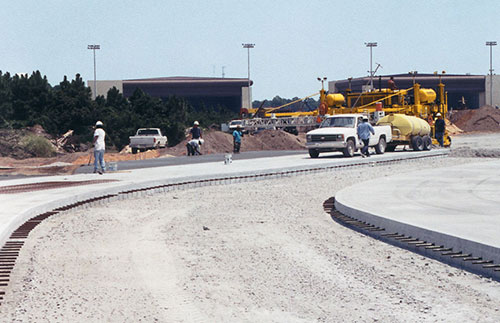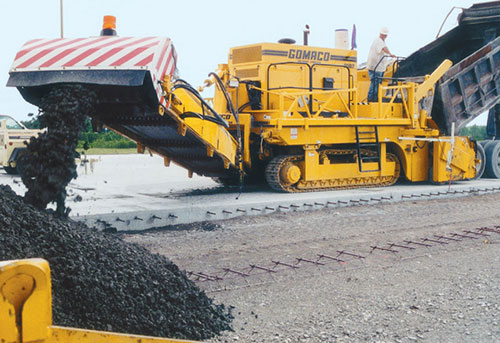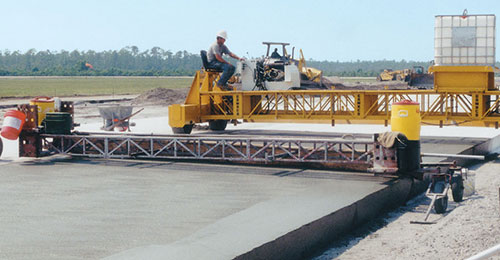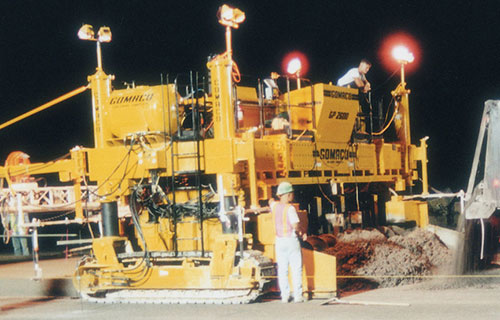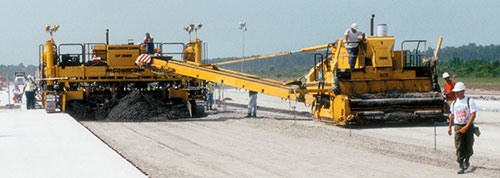GOMACO World Index --- GOMACO World 29.2 - June 2001
Planes Out, Pavers In
Hurlburt Field in the panhandle of Florida is home to the 16th Special Operations Wing of the United States Air Force. Their motto, "Any Place, Any Time," took on a new meaning this past year when they left their base so its runway could be repaired.
There is only one runway at Hurlburt Field. The asphalt runway had been rehabilitated many times during its 50-year life span and was at a point where it couldn't be fixed anymore. The decision was made to remove the existing asphalt and replace it with concrete.
R.C. Construction Company, Inc., based out of Greenwood, Mississippi, specializes in military construction and was chosen for the fast-track project.
R.C. Construction was given 120 days to mobilize, stockpile aggregates, and prepare for the $10 million runway project.
With mobilization complete, work could begin on the project. The planes were flown out to nearby Eglin Air Force Base and the runway was shut down at Hurlburt Field. Sixty-eight days later, the airplanes returned to land on a brand new concrete runway.
That was the reason for the fast-track project. The project was to get the planes out, let R.C. Construction do their work, and then bring the planes back.
In just 68 days, R.C. Construction removed 30,000 tons of existing asphalt, 47,602 yd2 (39,800 m2) of asphalt was milled to grade, 15,800 metric tons of asphalt was used for leveling, 50,592 yd2 (42,300 m2) of subgrade was trimmed with a GOMACO 9000, the entire lighting system was reworked, and 137,978 yd2 (115,363 m2) of concrete was placed on the runway and three taxiway tie-ins. The entire runway project was 8000 feet (2438 m) long and 150 feet (46 m) wide.
The runway was closed on June 14. At that time, the existing asphalt was removed. The surface was then either trimmed to grade with a GOMACO 9000 or a 9500 trimmer or had asphalt leveling put on to bring it up to grade.
Paving started while work was still being completed on the grade. R.C. Construction used a rented 9500 to place concrete and kept their 9000 trimming. Concrete widths and thicknesses varied according to Corps' specifications.
R.C. Construction used either a GP-2000 or GP-2600 paver to accommodate the eight different paving passes with varying requirements. The 9000 was also used to place concrete in front of the pavers.
The GP-2000 slipformed two lanes 12.4 feet (3.78 m) wide. The GP-2600 paver slipformed four lanes of 18.9 feet (5.75 m). It was then extended out to pave two lanes 24.8 feet (7.57 m) wide to complete the project.
"It worked well having the two pavers on the job," John Powers, vice president of R.C. Construction, said. "We were pulling different widths with the different pavers. We had the GP-2600 set up to do the wider, thicker concrete and the GP-2000 did the narrower, thinner pours."
Concrete depth varied according to the project's specifications. The thickest concrete was 14.5 inches (368 mm) and the thinnest was 7.5 inches (191 mm).
Holes were drilled and dowels were epoxied into the edge of the slab every 15 inches (381 mm) on center in the thicker pavement and 12 inches (305 mm) on center in the thin pavement.
R.C. Construction's GP-2600 was purchased new for this project. "We began using GOMACO equipment in the late 1980s and we've had total satisfaction with it," Powers explained. "The GP-2600 seemed to be the paver for this job."
Concrete slump averaged one inch (25 mm). A basic concrete mix design with cement, fly ash, aggregates from Indiana and local sand was used.
There's no availability of aggregates in the panhandle of Florida. Aggregate was brought in by barge from a quarry on a river in Indiana. Barging is the traditional way of getting aggregates to the Florida panhandle.
A minimal amount of finishing work was done to the slab. A burlap drag was applied behind the paver with the final finishing work accomplished by the Auto-Float®. A 4000 series powered Spanit® with cure system applied the white cure.
A majority of the project was paved at night to avoid hot daytime temperatures. Daytime temperatures in the panhandle averaged 95 to 100 degrees (35 ºC). Nighttime temperatures would average around the mid 70's (24 ºC).
The daytime hours would be spent on prep work, setting stringline and getting ready to pave. A different crew would come in ready to pave at night during the cooler temperatures.
Phase one of the Hurlburt Field project was completed on August 20, 68 days after it began. Powers gave credit for the timely completion of the project to his crew.
"R.C. Construction's dedicated employees were willing to work 16 hour shifts, seven days a week," Powers commented. "My people went the extra mile, worked extra time and got it done."
The planes returned from Eglin Air Force Base and the fast-track portion of the project was complete. Phase two of the project could begin.
Phase two work consisted of 204,521 ft2 (19,000 m2) of concrete pavement with asphalt shoulders and lighting rework.
Eighty days after beginning Phase two, it was complete and R.C. Construction's work at Hurlburt Field was complete.
Subscribe to Receive GOMACO World Magazine

